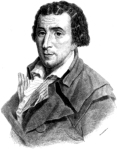In Chapter 1, ‘The Merchants’ Children’, I describe how important emotionally Uncle William (1721-77) and Aunt Hannah (née Thornton; d. 1788) Wilberforce – the Wimbledon Wilberforces – were for the young Wilberforce. A fine portrait in oils of William and Hannah, c. 1750, by Joseph Highmore (1692-1780) may be seen at the Wilberforce House Museum in Hull, and can be viewed online as part of the BBC’s ‘Your Paintings’ Project. When taken out of their care, the distraught 12-year old boy wrote in a letter that he would give anything in the world to be with them again. [Bodleian Library, MS Wilberforce, c. 51, of. 100]
The Wimbledon Guardian has a very interesting article on the elder Wilberforces’ house, known to them as Laurel Grove but subsequently named Lauriston House off Wimbledon Common, Southside. Here is an extract from the article:
‘When [the house] was demolished in 1957, a priceless ceiling painted by the famous Swiss Neoclassical artist Angelica Kauffmann (1741-1807)) was lost forever.
The house had also been the home of the anti-slavery campaigner William Wilberforce.
Originally known as Laurel Grove, Lauriston House was built in 1724 for William Jackson.
It was set in three acres and next to four cottages pre-dating 1684 which became the stable block. Jackson’s widow sold the house in 1752 to Wilberforce’s uncle. He commissioned Kauffman to paint magnificent murals for the main stairwell and in 1782 his famous nephew moved in to enjoy them.
Wilberforce’s friend, William Pitt the Younger, was then Chancellor of the Exchequer and about to become Prime Minister. He became a regular visitor…
Wilberforce left the house in 1786 and launched his long anti-slavery campaign the next year but Pitt continued to visit Wimbledon regularly as his Cabinet colleagues Richard Grenville and Henry Dundas also lived nearby, respectively in Eagle House and what later became Cannizaro House.’
Wilberforce left the house following his evangelical conversion. He wanted to move nearer to the House of Commons in order to be a more effective MP. For his country retreat, he now used the Clapham home of the wealthy merchant, John Thornton. Its demolition is a typical example of post-war vandalism.
